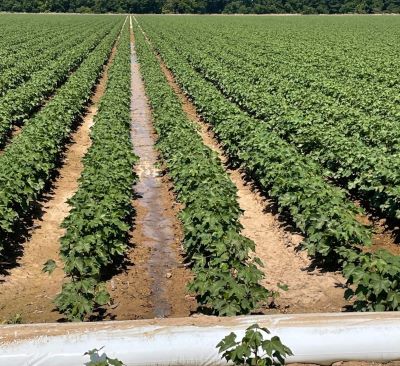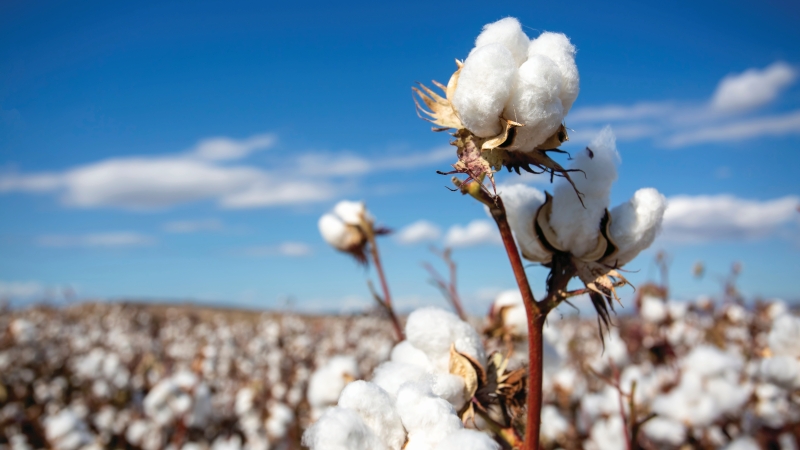Crop Scan Ag Report: The Heat Is On
Temperatures climbed into triple digits across most of the Cotton Belt in the past week. Combined with some timely rains and/or irrigation, cotton has responded and is playing catch up after a mostly cool and wet or dry start. Our contributing cotton consultants say weeds are mostly under control and the focus shifts to insect management, especially plant bugs and fleahoppers.
Here’s their report for early July.
Chad Harrell owns and operates Harrell Agronomic Services in Northeastern North Carolina.
A lot has changed since the last update. Last week, we were able to get some widespread, much needed rain, allowing the cotton to finally take off. Most of the cotton is now 8-11 nodes and looking much better. We should see some blooms in a couple of weeks.
Plant bugs have picked up recently with a few fields reaching threshold. I expect to see higher pressure with more fields being treated this week along with some PGR applications.
Most growers are now side dressing and finishing up with weed control. The cotton is still about 2-3 weeks behind normal schedule.
Wes Briggs consults on cotton, corn, peanuts, soybeans, and small grains for growers in Georgia, Alabama, and Florida.
We’ve replanted cotton that was damaged by hail, but most of that went to soybeans because it was just too late to go back to cotton. I’ve probably lost 25% of the cotton acres that we scout.
We got rain throughout the hail that we had, but it’s dried out fast through these hot days. With 110 heat index, it doesn’t take very many of those days to dry things out, even behind some 5-to-6-inch rains.
We have some cotton that just went into bloom this week. We’re seeing a little bit of aphid fungus. But in cotton in South Georgia, plant bugs are still top of the list. Anyplace we have pinhead squares, we’re treating for plant bugs. We’ve had to spray for a few spider mites, and they seem to be building back again in a few isolated areas. But mainly, we’re seeing tarnished plant bugs moving into cotton.
We’re finishing up weed sprays. Our dicamba cutoff for soybeans was today (June 30), but we still have a little time left on cotton. We’re just cleaning up the weeds and getting ready to sidedress with either potash or liquid nitrogen or both.
Cotton seems to be shaping up. It’s starting to look like cotton is supposed to look.
It’s been a pretty rough start. We were cool during planting season, and I don’t think our stands were up to par. We went through a lot of wind and rain that beat things up pretty well. We also saw a bit more herbicide burn, which you normally get when you’re spraying wet ground.
Cotton is rebounding from all of that. We seem to be pointing in the right direction if Mother Nature will cooperate with us a little bit. We’re going to need another rain pretty soon on our dryland acres.
Tucker Miller is a Mississippi-based independent private consultant for cotton, soybeans, corn, peanuts, rice, and vegetables.
Cotton in our area ranges from nine nodes to 14 nodes with the oldest just starting to bloom. Most of our cotton is about a week away from blooming.
Our major pest, the tarnished plant bug, is starting to migrate in at this time. We are picking up threshold numbers, especially next to corn. Most of our cotton is receiving the second shot for plant bugs. We are using acephate plus Diamond and Transform plus Diamond. We are also applying PGRs where needed. Varietal differences require different amounts of Pix. We try to keep our height to node ratio at two or less.
We received a nice rain last week, but we are ready for another rain now. A lot of our cotton has been laid by, and we are getting the last shot of fertilizer out. We will be cutting on pivots to activate and laying pipe to start watering the first week of July if it doesn’t rain.
 Photo: Tucker Miller
Photo: Tucker Miller
The high winds with the last rain laid some corn down, but our cotton wasn’t affected. Most of our corn is getting the third watering at this time.
Our soybeans are at R-4 and have received a fungicide application. Insects have been low in our beans thus far.
Mark Nemec is an independent agricultural consultant for cotton, wheat, grain sorghum and corn in the Blacklands and Brazos River Bottom area of Central Texas.
The heat is on here in Central Texas. There is a strong heat dome centered over us that has caused oppressive heat conditions. The temps have been hovering around 100 degrees for the last couple of weeks with heat indexs between 110 and 120 or so. This has made a lot of heat units for our cotton, and it is showing. The crop is fruiting up fast now with most fields blooming currently.
With no rainfall lately, irrigation has begun in the Brazos River Bottoms. The drought last year is still giving us problems as our rivers are still low and have not been able to recharge our irrigation aquifer. There are some areas that can’t run all their pivots the way that they normally would.
Fleahopper numbers have finally calmed down in most fields, just in time for bollworms to start coming in. Corn acres are up substantially here, so we should see high pressure moving to cotton fields. There is still some two-gene cotton grown around here, and farmers should watch it extra closely. Stinkbugs are also starting to move out of corn fields looking for their next green meal.
PGRs are being applied ahead of the water on irrigated areas as well as dryland fields that still have good moisture under them. It took a while, but most weeds have been taken care of after a long battle.
Kerry Siders is Texas A&M AgriLife Extension Agent-IPM for Hockley, Cochran, and Lamb Counties.
Well, the Good Lord has been answering prayers. First, we needed rain. Done. Then we needed it to clear up and warm up. Done. However, it has been too much of a good thing here of late. We have been 100 degrees plus the past several days, and averaging 25+ heat units (DD 60’s) per day.
Fortunately, the cotton rooted down very well into the moisture from back in May and early June and is suffering through this heat well. Generally, producers have been starting up irrigation systems. The forecast is calling for more moderate temperatures as we move into July and a possibility of some rain which we have not seen on the western plains of the Texas High Plains in several weeks.
A great majority of our cotton acres went in the last week of May through the first 10 days of June. So, very little cotton is yet to square. Earlier planted cotton which survived all sorts of challenges has 1-4 first position squares, with very good retention.
No fleahoppers have been found on cotton causing issues based on my scouting efforts. I can find fleahoppers though in field margins hanging out on silverleaf nightshade. So, be vigilant and scout frequently. We want to achieve better than 70% square retention after the first 3 weeks of squaring.
Based on plant mapping information, our internode length is very tight (average less than 0.5”). If we moderate temperatures back into the mid-90s, receive some rainfall, and you have fertility in place, I might anticipate more rapid growth over the next few weeks.
Since we are a few weeks behind ideal growth development, I would highly recommend a light dose (4-8 oz) of a plant growth regulator (mepiquat chloride) over the next few weeks (by July 15). This can help with fruit retention, balance out vegetative growth with reproductive growth, and can enhance maturity at end of season. Also, if we do have a late growth spurt, it will be easier to manage having already built some PGR ppm into the plant.















